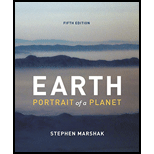
The description regarding three different kinds of material that can erupt from a volcano.
Answer to Problem 1RQ
Lava is molten rock that flows out of the volcanic flanks in liquid state, cools, and solidifies on the Earth’s surface. Pyroclastic debris forms when molten lava chunks are ejected into the air and cools during flight to form volcanic glass; pyroclastic debris ranges in size from ash to lapilli to larger pieces termed as bombs. Blocks are fragments of pre-existing volcanic rocks from older eruptions that are hurled by the force of eruption. Lastly, the primary gases that erupt from volcanoes are water vapor, carbon dioxide, sulfur dioxide, and hydrogen sulfide.
Explanation of Solution
A volcanic eruption occurs when hot lava, tephra, and a mixture of gases discharge through a vent.
There are three forms of product of an eruption, namely lava flows, pyroclastic debris, and gas. The term 'lava flow' is used for molten, moving layer of lava as well as for the solid layer of rock that forms when the lava freezes.
Lava flow:
Magma reaching the Earth's surface through fissures and volcanic vent is called lava. Lava flow is the movement of lava outpouring in a quiescent effusive eruption that cools and crystallizes on the surface of the Earth.
Lava behaves in various ways depending on its viscosity (resistant to flow) nature. Lava sometimes flows down the flanks of a volcano like a fast moving, incandescent stream, sometimes it builds into a rubble-covered pile at the summit of volcano, and sometimes it oozes out into blobs like a sticky and blistering paste. In general, lava is in a molten state, which flows out of the volcanic vent in relatively liquid state, cools down due to temperature change, and solidifies on the surface of the Earth.
Pyroclastic debris:
Pyroclastic debris are fragments of lava ejected forcefully into the atmosphere, cools, and solidifies mid-air soon after it reaches the land. Pyroclastic debris occur in various sizes ranging from volcanic ash which are less than 2 mm, pea-size fragments called lapilli and larger pieces called bombs and blocks. Volcanic bombs are made up of molten lava and are cooled once they are ejected, while the volcanic blocks are solid fragments of pre-existing volcanic rocks from old eruptions that are forcefully ejected out. Bombs contain polished surfaces while blocks are chunky angular fragments.
Volcanic gas:
Majority of magma contains mixture of dissolved gases that include water (H2O), carbon dioxide (CO2), sulfur dioxide (SO2), and hydrogen sulfide (H2S). These dissolved gases are released out of solution when the magma reaches the Earth’s surface.
Want to see more full solutions like this?
Chapter 9 Solutions
Earth: Portrait of a Planet (Fifth Edition)
- According to the views of animal rights activists opposed to animal experimentation which of the following statements applies? Animal experimentation should be permitted only when medical progress cannot be achieved in any other way. Animal experimentation should be permitted only when the animals involved come from a shelter where they were destined to be killed. Animals have the same rights and moral status that human beings do. We should not apply Kant's Practical Imperative to animals.arrow_forward72 ic 18 The planets 1 Can you find eleven Solar System words in the grid? e E W b V e n a e P r r + h C i - PU 0 0 n c e t S c e r P W n P i t e r U 6 r f U n - K σ г m a r S n W e t Y g n d r e E C Y O P U S t a r > S a t U r n 2 Rearrange the letters into the names of the planets. a ucerr My c un Ves e hrtEa g sarM b ruepitj d rntSau f uneNtep_ h nasu Urarrow_forwardAnswer the photoarrow_forward
- what are your thoughts on the critical importance of soil management and its impact on agricultural productivity and environmental health, and role of conservation tillage. write in first personarrow_forwardFive arguments that the Water Bottle Bill was passed as a means of "revenue" enhancement In developing your arguments you should start at the website of the Connecticut State Library which contains the history of all legislation passed by the Connecticut Legislature http://ctstatelibrary.org/leghistory_ to gather the information for your arguments. use referencesarrow_forwardDescribe the importance of recycling household solid wastesarrow_forward
- Why is food waste a growing concern? Describe how some communities are addressing the food waste issue.arrow_forwardDescribe examples of source reductionarrow_forwardIncineration of solid waste is controversial. Do you support solid waste incineration in general?Would you support an incineration facility in your neighborhood?arrow_forward
- Describe why electronic waste is becoming a major problem.arrow_forwardHow does Gateway Community College or Norwalk, CT deal with solid waste? Can solid waste production be limited at your institution or city? How? What barriers exist that might make it difficult to limit solid waste production?arrow_forwardIt is possible to have a high standard of living, as in North America and Western Europe, and not produce large amounts of solid waste. How?arrow_forward
 Applications and Investigations in Earth Science ...Earth ScienceISBN:9780134746241Author:Edward J. Tarbuck, Frederick K. Lutgens, Dennis G. TasaPublisher:PEARSON
Applications and Investigations in Earth Science ...Earth ScienceISBN:9780134746241Author:Edward J. Tarbuck, Frederick K. Lutgens, Dennis G. TasaPublisher:PEARSON Exercises for Weather & Climate (9th Edition)Earth ScienceISBN:9780134041360Author:Greg CarbonePublisher:PEARSON
Exercises for Weather & Climate (9th Edition)Earth ScienceISBN:9780134041360Author:Greg CarbonePublisher:PEARSON Environmental ScienceEarth ScienceISBN:9781260153125Author:William P Cunningham Prof., Mary Ann Cunningham ProfessorPublisher:McGraw-Hill Education
Environmental ScienceEarth ScienceISBN:9781260153125Author:William P Cunningham Prof., Mary Ann Cunningham ProfessorPublisher:McGraw-Hill Education Earth Science (15th Edition)Earth ScienceISBN:9780134543536Author:Edward J. Tarbuck, Frederick K. Lutgens, Dennis G. TasaPublisher:PEARSON
Earth Science (15th Edition)Earth ScienceISBN:9780134543536Author:Edward J. Tarbuck, Frederick K. Lutgens, Dennis G. TasaPublisher:PEARSON Environmental Science (MindTap Course List)Earth ScienceISBN:9781337569613Author:G. Tyler Miller, Scott SpoolmanPublisher:Cengage Learning
Environmental Science (MindTap Course List)Earth ScienceISBN:9781337569613Author:G. Tyler Miller, Scott SpoolmanPublisher:Cengage Learning Physical GeologyEarth ScienceISBN:9781259916823Author:Plummer, Charles C., CARLSON, Diane H., Hammersley, LisaPublisher:Mcgraw-hill Education,
Physical GeologyEarth ScienceISBN:9781259916823Author:Plummer, Charles C., CARLSON, Diane H., Hammersley, LisaPublisher:Mcgraw-hill Education,





